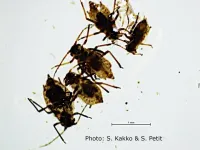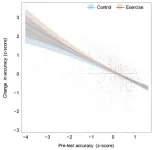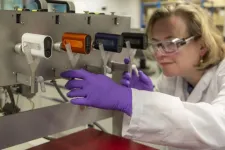(Press-News.org) An invasive species of aphid could put some threatened plant species on Kangaroo Island at risk as researchers from the University of South Australia confirm Australia's first sighting of Aphis lugentis on the Island's Dudley Peninsula.
It is another blow for Kangaroo Island's environment, especially following the Black Summer bushfires that decimated more than half the island and 96 per cent of Flinders Chase National Park.
Collected by wildlife ecologist Associate Professor Topa Petit and identified by colleagues from the WA Department of Primary Industries and Regional Development, the black aphids were found feeding on seedlings of Senecio odoratus, a native species of daisy, commonly known as the scented groundsel.
Of 16 native Senecio species on the island, at least ten are of conservation concern.
Originating from North America, the sap-sucking black aphids have spread across multiple continents over the past 20 years. This first record of the pest in Australia.
Assoc Prof Petit says the alien aphid species could threaten plants in the Compositae (daisy) family.
"Aphids were tended by several species of native ants that were feeding on their honeydew, showing easy integration for the pest in its new environment," Dr Petit says.
"The presence of Aphis lugentis on Kangaroo Island could have serious consequences on seedling survival of Senecio and related species - as well as unknown ones for native ant communities."
Currently, 1,257 of Australia's threatened and endangered species are directly affected by 207 invasive plants, 57 animals and three pathogens. The most recent estimates found the cost of controlling invasive species and economic losses to farmers in 2011-12 was A$13.6 billion.
Once established across Australia, invasive species can be very difficult to eradicate.
Entomology diagnostician, Cameron Brumley from the Department of Primary Industries and Regional Development in Western Australia, and geneticists Monica Kehoe and Cuiping Wang, examined the aphid and found matching DNA in a collection from Hurstville, NSW, indicating the greater spread of aphid across Australia. Authorities have been alerted.
"It is still unclear how some fragile species of Kangaroo Island are coping following last year's bushfires, so I recommend that attention be paid to aphids present on plants related to daisies, on the island, but also on the mainland considering the likely presence of the aphid in other states. Its distribution needs to be mapped," Dr Petit says.
"This aphid was probably introduced to Australia on ornamental plants. Locally native plants and native gardens offer better habitats for native wildlife and lower invasion risks. We need to learn to appreciate our remarkable native flora."
INFORMATION:
Notes to editors:
Australia has a long history of invasive species, with more than 3000 species introduced to Australia since 1770. Some of the most notorious examples of invasive species include:
The CANE TOAD - Introduced to Australia in the 1930s as a biological control for sugar cane beetles, its population has grown from 102 to more than 200 million, wreaking havoc on the Australian ecosystem at a rate of 50km every year.
PATERSON'S CURSE (or Salvation Jane) - This purple-flowering plant was introduced to Australian gardens in the 1880s, but quickly became a rampant weed. Now a target for biological control, it costs the Australian economy more than $250 million annually through lost productivity in pastures, control costs, and wool contamination.
EUROPEAN RABBITS - Introduced for hunting and food in the 1850s, Australia's new rabbit population exploded, destroying crops, native flora, and land. Biological controls including the Myxoma Virus and the Rabbit Hemorrhagic Disease Virus have helped control populations.
RED FIRE ANTS - Native to South America, these are highly invasive, aggressive ants that have a venomous and repetitive sting that can cause painful pustules, and anaphylaxis. The Federal Government now has a ten-year, $411 million plan to eradicate red fire ants from Southeast Queensland.
Media contact: Annabel Mansfield T: +61 8 8302 0351 M: +61 417 717 504
E: Annabel.Mansfield@unisa.edu.au
Researcher: Assoc Prof S. "Topa" Petit T: +61 8 8302 5194 E: Sophie.Petit@unisa.edu.au
Over the past 20 years, many studies have investigated the effects of acute aerobic exercise on cognitive performance. In recent years, meta-analyses*1 of data from these previous research studies have demonstrated that these a single bout of moderate aerobic exercise temporarily improves cognitive performance. However, close examination of the individual research studies on this topic revealed that in approximately 50% of studies, no beneficial link between acute aerobic exercise and cognitive function was found.
An international research collaboration, including Associate ...
Ibaraki, Japan - Flowers come in a multitude of shapes and colors. Now, an international research team led by a researcher from Japan has proposed the novel hypothesis that trade-offs caused by different visitors may play an important role in shaping this floral diversity.
In a study published last month, the team explored how the close associations between flowers and the animals that visit them influence flower evolution.
Visitors to flowers may be beneficial, like pollinators, or detrimental, like pollen thieves. All of these visitors interact with flowers in different ways and exert different selection pressures on flower traits such as color and scent. For example, a scent that attracts one pollinator may deter other potential pollinators. In this case, the flower would be expected ...
Almost twenty years ago, the process of RNA silencing was discovered in plants, whereby small fragments of RNA inactivate a portion of a gene during protein synthesis. These fragments--called microRNAs (abbreviated as miRNAs)--have since been shown to be essential at nearly every stage of growth and development in plants, from the production of flowers, stems, and roots to the ways plants interact with their environment and ward off infection.
The detection and characterization of miRNAs is an active field of research. In the decade following their discovery in plants, over 1,000 bioinformatic tools were used to identify ...
Sophia Antipolis - 1 July 2021: Heart failure patients aged 80 and above are less likely to receive recommended therapies and dosages compared to their younger counterparts, according to research presented today at Heart Failure 2021, an online scientific congress of the European Society of Cardiology (ESC).1
"Guidelines recommend the same treatments for all heart failure patients regardless of age," said study author Dr. Davide Stolfo of the Karolinska Institute, Stockholm, Sweden.2 "Our analysis adjusted for other conditions that might justify withholding ...
As the COVID-19 pandemic exploded across the globe in early 2020, the world's leaders were faced with a flurry of tough moral dilemmas. Should schools and businesses shut down, and if so, for how long? Who should receive scarce resources, such as ventilators, when there wouldn't be enough for everyone? Should people be required to practice contact tracing to control the spread of infection? Should life-saving medicine be held for a country's own citizens or shared with those in greater need?
Some global leaders advocated for a utilitarian approach to these dilemmas: impartially maximizing the greatest good for the greatest number of people, even if that would come at the cost of harming a minority of the population. Utilitarianism, however, is a controversial ...
1 July 2021: Despite only limited evidence that fertility add-ons increase the odds of having a baby, the majority of women (82%) have used one or more of these treatments as part of their IVF.
This is the conclusion of a retrospective study of 1,590 Australian patients which also found more than seven in 10 (72%) had incurred additional costs for these unproven additional therapies and techniques which range from Chinese herbal medicine to endometrial scratching.
The results based on an online survey into prevalence of these optional extras will be presented today by principal investigator Dr Sarah Lensen, a researcher from the University of Melbourne, Australia, at the 37th virtual Annual Meeting of ESHRE.
The findings, says Lensen, suggest ...
Bottom Line: For women diagnosed with breast cancer in Florida, breast cancer-specific mortality rates have decreased more among Black and Hispanic women than white women since 1990. Despite these advances, Black women still have double the five- and 10-year mortality rates of non-Hispanic white women.
Journal in Which the Study was Published: Cancer Epidemiology, Biomarkers & Prevention, a journal of the American Association for Cancer Research.
Author: Robert Hines, PhD, MPH, associate professor of population health sciences at the University of ...
Evidence shows significant reduction in indicators of potential harm over 6-months for smokers switching to exclusive use of glo compared with continuing to smoke cigarettes
Gold-standardi indicator supports scientific substantiation of glo's potential as a reduced risk product*
First ever long-term study showing sustained reduction in exposure to certain toxicants and indicators of potential harm in smokers switching completely to glo
Supports BAT's delivery of A Better TomorrowTM by reducing the health impact of its global business by encouraging ...
New research from marine biologists offers answers to a fundamental puzzle that had until now remained unsolved: why are some fish warm-blooded when most are not?
It turns out that while (warm-blooded) fish able to regulate their own body temperatures can swim faster, they do not live in waters spanning a broader range of temperatures.
The research therefore provides some of the first direct evidence as to the evolutionary advantage of being warm-blooded as well as underlining that species in this demographic - such as the infamous white shark and the speedy bluefin tuna - are likely just as vulnerable to changing ...
Nanosized molecules of a particular chemical element can inhibit the formation of plaque in the brain tissues. This new discovery by researchers at Umeå University, Sweden, in collaboration with researchers in Croatia and Lithuania, provides renewed hope for novel treatments of, for instance, Alzheimer's and Parkinson's disease in the long run.
"This is indeed a very important step that may form the basis of new and efficient treatments of neurodegenerative diseases in the future," says Professor Ludmilla Morozova-Roche at Umeå University.
When proteins misfold they form insoluble fibrils called amyloids, which are involved in several serious diseases such as Alzheimer's and Parkinson's, Corino de Andrade's and the mad cow ...





